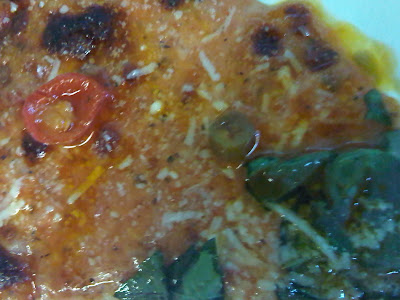Easter is upon us and we attended a wonderful dinner party at our friend's - Adrianne and Matt's - place in Park Slope. As always, Matt made a perfect leg of lamb & friends were encouraged to brings sides to compliment. It is a large gathering of over 20 people so it helps to have a second main course, which I volunteered for.
We have a rotisserie, which my wife and I adore, and we also love duck, ergo BBQ Duck for Easter - two to be exact.
I basically went in the tradition of classic Chinese Roast Duck, which I got fresh in Chinatown. Pics of the process are below.
First I trimmed the ducks and removed excess fat.

Then I poured boiling water on them to tighten the skin making them easier to roast and crispier later on.

Here you can see that the skin is more taught and better for roasting. I stuffed them with oranges, garlic and ginger and made sure to prick the skin to allow excess fat to cook away.

Then i made a glaze using the Chinese Five Heavenly Spices (they seem to differ depending on what source you find. Linda was my source as she introduced me to it years ago, but denies it vehemently). I used Szechuan peppercorns, star anise, cinnamon, ground ginger & cloves. I reduced the spices in cooking sherry, honey, soy sauce, orange peel, scallions and loads of garlic until it was a nice sticky glaze.

I put them on the rotisserie and let them go for 3 hours, removing all the excess rendered fat at the bottom periodically. Every half hour, I put a layer of glaze which cooked into the skin and made a fantastic crust.

I then chopped up the ducks and sprinkled fresh scallions and cilantro over them for the party. Everyone enjoyed them and I was extremely pleased with the result.




 The lamb was removed, cooled and the chops separated. A sharp knife is helpful here so you do not break the crunchy crust that has formed. I definitely prefer my lamb as close to rare as possible in order to enjoy the moist tenderness and clean flavor.
The lamb was removed, cooled and the chops separated. A sharp knife is helpful here so you do not break the crunchy crust that has formed. I definitely prefer my lamb as close to rare as possible in order to enjoy the moist tenderness and clean flavor.
 The lamb chops were served on a root vegetable confit (parsnip, turnip, carrots, potatoes slow roasted in olive oil with rosemary and smoked paprika) and chard greens wilted in white wine and soy sauce. It was a grand dinner served with a traditional style full bodied red.
The lamb chops were served on a root vegetable confit (parsnip, turnip, carrots, potatoes slow roasted in olive oil with rosemary and smoked paprika) and chard greens wilted in white wine and soy sauce. It was a grand dinner served with a traditional style full bodied red.
 I then browned the meatballs in olive oil until dark and crusty which would be a base form my red sauce. I removed the meatballs, added garlic, onions, and more red pepper flakes then deglazed the pan with white wine. Then I added a small can of italian cherry tomatoes which I REALLY recommend for making sauces. I crushed the whole tomatoes, added some water and brought to a simmer for about 1/2 an hr. I re-added the meatballs and simmered until tender. Then seasoned with black pepper and ground sea salt.
I then browned the meatballs in olive oil until dark and crusty which would be a base form my red sauce. I removed the meatballs, added garlic, onions, and more red pepper flakes then deglazed the pan with white wine. Then I added a small can of italian cherry tomatoes which I REALLY recommend for making sauces. I crushed the whole tomatoes, added some water and brought to a simmer for about 1/2 an hr. I re-added the meatballs and simmered until tender. Then seasoned with black pepper and ground sea salt.














